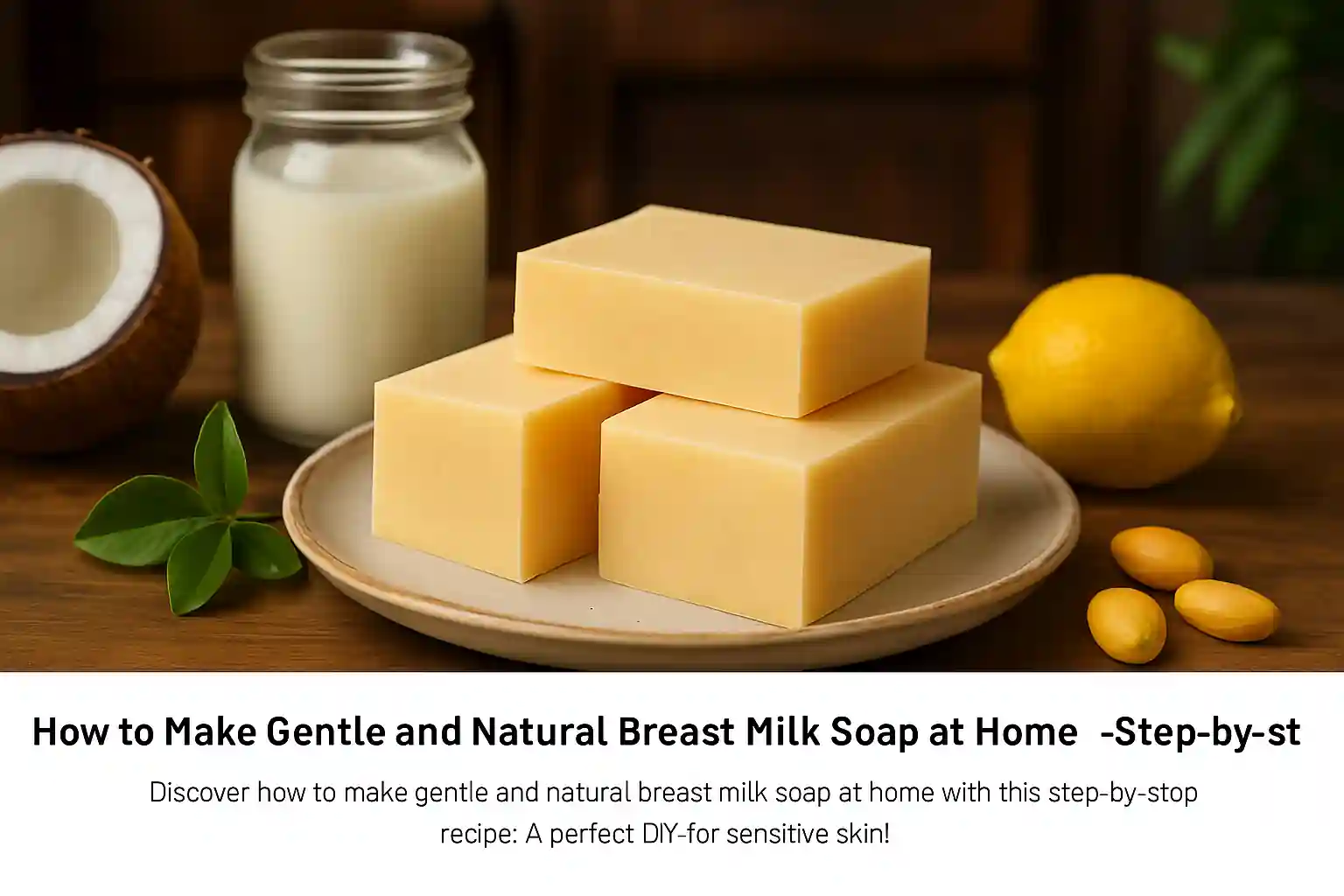Breast Milk Soap Recipe: A Gentle Guide to Natural Soapmaking
Understanding Soap and Its Benefits
Soap is a daily essential for hygiene, but not all soaps are created equally. Natural soaps, especially those made at home, can offer a more nourishing and chemical-free experience for the skin. This is especially true for breast milk soap, which has become a popular option among parents and skincare enthusiasts.
What Is Breast Milk Soap?
Breast milk soap, often referred to as breastmilk soap or bm soap, is a type of homemade soap that incorporates human breast milk into its formula. Due to the rich nutrients and antibodies found in breastmilk, this type of soap is believed to be especially beneficial for sensitive skin and babies. Many mothers find this a meaningful way to use extra or expired frozen milk.
Making Breast Milk: Why It Matters in Soapmaking
Making breast milk is a natural biological process that allows mothers to nourish their infants. However, there are times when there is extra milk or expired milk that can no longer be used for feeding. Rather than letting it go to waste, many turn to soapmaking as a creative and practical way to use milk.
Breast Milk Soap and Eczema Relief
One major benefit of breastmilk soap is its potential to soothe eczema. Because breastmilk contains lauric acid and other immune-boosting properties, many soap makers report that using breast milk soap on baby skin reduces inflammation, calms irritation, and moisturizes dry patches.
The Cold Process Soap Method
What Is Cold Process Soap?
Cold process soap is a traditional method of making soap from scratch. It involves mixing oils with a lye solution (sodium hydroxide and water or milk) and allowing the soap to cure over several weeks. When using milk, such as goat’s milk or breastmilk, special care must be taken to prevent scorching.
Using Milk in Cold Process Soap
Milk cold process soap requires milk to be either frozen or very cold. This prevents the sugars in the milk from scorching when mixed with lye. Milk might turn a bright orange or yellow if it gets too hot, which doesn’t harm the soap but may alter the appearance.
Why Freeze the Milk?
To avoid overheating and scorching, soapmakers typically freeze the milk. Cold or even frozen milk helps keep the mixture temperature low during saponification. This technique is crucial when making soap using human milk, as it preserves its nutritional integrity.
Milk Soap Recipe: Cold Process Version
Here is a detailed breast milk soap recipe using the cold process method:
Ingredients:
- 12 oz olive oil (or a blend of oils)
- 8 oz coconut oil
- 2 oz shea butter
- 4.4 oz frozen breastmilk (or other type of milk like goat milk)
- 2 oz lye (sodium hydroxide)
- Optional: 10–20 drops of essential oil (like lavender or chamomile)
Tools:
- Stainless steel or plastic mixing bowls
- Lye-safe container (no aluminum)
- Digital scale
- Thermometer
- Immersion blender
- Silicone soap mold
- Safety gear (gloves, goggles)
Instructions:
- Freeze the milk in ice cube trays.
- Measure the lye carefully using a digital scale.
- Add the lye crystals slowly to the frozen milk, not the other way around, to prevent the milk from scorching.
- Mix the lye into your milk until it is fully dissolved.
- Heat the oils (olive oil, coconut oil, shea butter) until melted, then cool to around 100°F.
- Pour the lye mixture into the oils while using an immersion blender.
- Blend until you reach “trace” (the soap mixture thickens and leaves a visible trail).
- Add essential oils if desired.
- Pour the mixture into a soap mold.
- Let the soap sit for 24-48 hours before unmolding.
- Unmold your soap and slice into bars.
- Cure the bars for 4-6 weeks to complete the saponification.
Melt and Pour Breastmilk Soap: A Simpler Alternative
For beginners wanting to make a batch quickly, the melt-and-pour soap base method is ideal.
Ingredients:
- 1 lb melt and pour soap base (goat milk or shea butter base works well)
- 4 oz breastmilk
- Essential oils (optional)
Instructions:
- Melt the soap base using a double boiler or microwave.
- Let it cool slightly before adding the breastmilk.
- Stir in essential oils.
- Pour into molds and let it harden for several hours.
This method avoids using lye directly and is perfect for those making homemade soap for the first time.
Choosing a Soap Base
The choice of soap bases depends on skin sensitivity and preferences. Goat milk soap and castile soap bases are popular for their moisturizing properties. Bastille soap (mostly olive oil) is gentle and ideal for sensitive skin, including newborns.
Lye and Milk: A Safe Mix
Mixing lye with milk can be intimidating, but it’s safe when done correctly. Always add the lye into the milk, not the reverse. Doing so prevents a volcano-like reaction and minimizes scorching risk.
Using a Lye Calculator to Make Soap
A lye calculator ensures accurate measurements of oils and lye. This is critical for achieving a balanced, non-lye heavy soap. Too much lye can irritate the skin, while too little results in a soft, oily bar.
Avoiding Common Mistakes
Scorch the Milk
Never pour lye into room-temperature or warm milk. It can scorch the milk instantly.
Overuse of Additives
Too much essential oil or add-ins like oatmeal can destabilize your soap mixture.
Lye Heavy Soap
If the finished soap is crumbly or causes skin irritation, it may be lye heavy. Let the soap cure longer or test with pH strips.
Forums and Community Advice
Joining a soapmaking forum helps connect with experienced soapmakers. These platforms offer recipes, troubleshooting tips, and encouragement.
Storage and Usage Tips
- Keep your homemade melt and pour soap in a cool, dry place.
- Use a ventilated soap dish to extend the soap bar’s life.
- Label with the making date and ingredients, especially if gifting.
Way to Use Breastmilk Soap
- For babies: Gentle cleansing and eczema relief.
- For adults: Nourishing face and body bar.
- As a gift: Personalized and sentimental present.
Milk Variants in Soap
While this guide focuses on breastmilk, other types of milk like goat’s milk and cow’s milk are also popular in milk soaps. Each type of milk brings unique nutrients, sugars, and fat content, which can affect the final product.
Benefits of Making Breast Milk Soap
- Reduces waste of expired frozen milk
- Natural and chemical-free
- Customizable scents and ingredients
- Gentle on sensitive or eczema-prone skin
- Promotes bonding and meaning in skincare
Homemade Soap vs. Commercial Soap
Homemade soap, especially breastmilk soap, lacks the synthetic detergents often found in commercial products. It’s more moisturizing, especially for baby skin and people with skin conditions.
Tips for Success
- Measure the amount of milk and lye accurately.
- Keep detailed notes for every soap you make.
- Try small batches before scaling up.
- Let the soap cure fully.
- Run it through a lye calculator to make sure your amounts are correct.
Final Thoughts
Making breast milk soap is not just a way to use extra milk—it’s a thoughtful, nurturing way to provide your family with safe, effective skincare. Whether you’re making cold process or melt-and-pour soap, every soap you make will carry personal value and natural benefits.
To learn more about cold process methods and natural skincare, you can explore The Natural Soapmaking Guide and Mother and Baby Health Resources.
Good luck with your soap!

